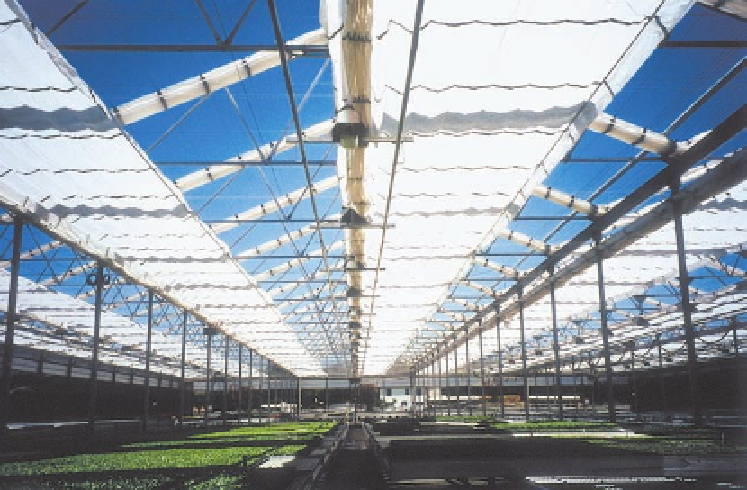Agriculture Reference
In-Depth Information
Photo 8.3.
The retractable roof greenhouse can provide maximum ventilation.
Greenhouses that are impermeable
to insects require forced ventilation. In
this case ventilation occurs preferably
by drawing air in from outside, to increase
the air pressure inside the building
relative to outside. The air inlets
must avoid allowing access of insects
(Photo 8.4).
It is preferable to use several small
fans instead of a large one, for the sake of
better uniformity. For plastic greenhouses,
the practical rule is to use a maximum fan
flow of 2.1-3.0 m
3
m
−2
of greenhouse
ground area (Boodley, 1996). With the aim
of optimizing the management under dif-
ferent climate conditions, it is very useful
if the fans have different rotation speeds
that can generate different rates of air
renewal, and which in turn may also limit
the energy use.
The efficiency of a mechanical venti-
lation system is of the order of 80%. In
the calculation of ventilation the height
above sea level must be considered, espe-
cially at very high altitude locations,
because the air density decreases with
height, reducing the efficiency of ventila-
tion. As a correction factor the barometric
pressures quotient obtained for the spe-
cific place and at sea level can be used
(Langhams, 1990).
8.6
Cooling by Water Evaporation
8.6.1
Pad and fan
In a greenhouse with a 'pad and fan' cooling
system, one of the sidewalls is equipped
with air extraction fans, and the other has
porous pads, which are kept wet. The exter-
nal air is drawn through these pads, evapo-
rating the water in the pads and being cooled,
and penetrates inside the greenhouse cooler
and more humid than before (Fig. 8.10). This
technique allows for temperature decreases
of 3-6°C under Mediterranean conditions
(Urban, 1997a). Its efficiency depends on the
dryness of the external air. With very low
humidity (RH < 20%) the temperature can be
decreased by up to 10°C (Hanan, 1998).
The distance to be travelled by the air
(between fans and pads) is a limiting factor,
40 m maximum, to avoid excessive tempera-
ture and humidity differences between differ-
ent greenhouse zones (Urban, 1997a). A good
water quality is also advisable, because other-
wise the salts in the water will soon block the
pads, which then will have to be replaced, at
significant cost. The water, if recycled, must
be filtered and treated with biocide for control
of algae. A recommended air renewal rate is
60 volumes h
−1
(ASAE, 1988).

